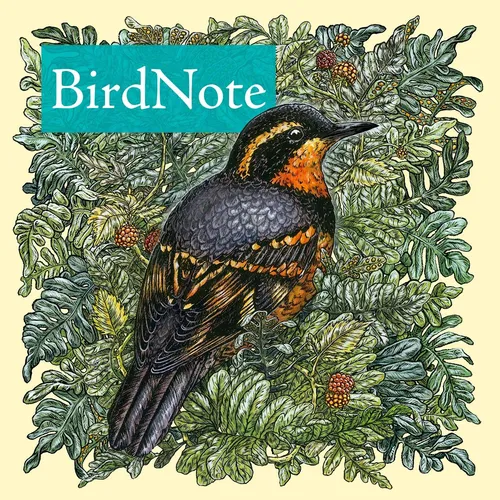
BirdNote Daily
Escape the daily grind and immerse yourself in the natural world. Rich in imagery, sound, and information, BirdNote inspires you to notice the world around you.
- Update frequency
- every day
- Average duration
- 1 minutes
- Episodes
- 1173
- Years Active
- 2022 - 2025

Learning to Listen - Patterns in Songs of the Song Sparrow
Heidi Hoelting, a musician, listens carefully to the songs of birds. In her piano studio at her home in the woods, she wrote down several variations of the different sounds a Song Sparrow makes. In t…

What Are Birds Saying
A bird’s crest is made up of a slender array of feathers on top of its head. These feathers are a bit longer and can be spiked up or slicked back, depending on what the bird is trying to communicate.…

A Drive Along on a Bar Ditch
In the rural Southeast, roadside ditches – known as “bar ditches” – carry on for miles. The term bar ditch probably comes from their construction, when dirt was "borrowed" to build up the road. The d…

Great Horned Owl III
This Great Horned Owlet - about 2-1/2 months old and already as big as its parents - is quite well feathered, although its underparts remain downy. Its wing and tail feathers are developing nicely, a…

American Kestrel
The American Kestrel is the smallest, most numerous, and most widespread North American falcon. This bird is built for speed, its long pointed wings often bent back at the tip. While hunting, kestrel…

Pigeons Make Milk
Pigeons, one of the most ancient of domesticated animals, feed their nestlings a peculiar, milky substance, straight from the adult’s beak to the baby’s throat. It’s called pigeon milk, a fat-rich su…

American White Pelicans
American White Pelicans have a nine-foot wingspan, nearly that of the California Condor. In summer, they breed mainly in the interior west of the United States and Canada, favoring shallow portions o…

California Quail, Up and Running
The most distinctive characteristic of the California Quail is the black, forward-facing topknot that juts out from its forehead like a small flag. The California Quail – the state bird of California…

How Much Birds Sing
A typical songbird belts out its song between 1,000 and 2,500 times per day. Even though most bird songs last only a few seconds, that's a lot of warbling! A Yellowhammer, a European bunting, may sin…

Thirsty Rufous Hummingbird
Hummingbirds need to consume five times their body weight each day. This Rufous Hummingbird of the West is looking for flowering plants to quench that mighty thirst on its spring migration. A feeder …

Delhi’s Jain Bird Hospital is Free
At Charity Birds Hospital, a small staff takes care of approximately twenty-six hundred birds at a time, providing antibiotics, medicine, food, and a safe place to rest for injured or sick birds. Th…

The Plover and the Hurricane
Piping Plovers are tiny, sand-colored shorebirds that nest on the beach. They’re threatened in much of their range. But plovers have gotten a boost from something rather surprising: hurricanes. Super…

Sean Hill on Nature, Place, and Black Life
Poet Sean Hill performs three poems that encapsulate his dynamic relationship to birds, travel and life as a Black wanderer in the great outdoors. First is The Western Tanager or Why Montana, a villa…

A Lost Hummingbird is Found Again
The Santa Marta Sabrewing is a hummingbird species so rare, they’ve only been documented twice in recent years. Native to the mountains of Colombia, they were officially described in 1946. No one rep…

White-throated Swifts
A pair of White-throated Swifts twists and turns, sailing through the air. Dashing headlong across the canyon toward an unyielding wall, the birds disappear at the last second into a slender crevice.…

The Early Bird
We've all heard that the early bird gets the worm. But research shows that birds dining early and heavily may lower their life expectancy. Socially dominant birds stay lean (and agile at avoiding pre…

The Legendary Phoenix
The ancient Greeks and Egyptians described a mythical bird called the Phoenix, a magnificent creature that was a symbol of renewal and rebirth. According to legend, each Phoenix lived for 500 years, …

What’s a Field of Grass to a Bird?
Although a field of grass might not seem like valuable habitat at first, many birds have adapted to nest in grassland habitats and nowhere else. In North America, birds such as the Bobolink seek out …

House Wrens and Dummy Nests
There may be no busier bird during the nesting season than a male House Wren. Just a day or so after completing his spring migration from the tropics, the male House Wren claims a territory and check…

Raising the World’s Deadliest Bird
You might think the first bird species that humans raised in captivity would be a relatively small one, like a chicken. But evidence suggests that people in New Guinea reared the cassowary, often cal…